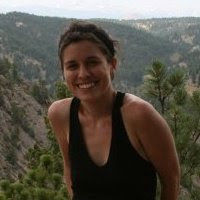
VORTEX2 had its first real mission today. We departed from Clinton, Oklahoma and rushed to Tulia, Texas. Then, as often happens when pursuing tornadoes, we waited and waited for a storm to start. Finally, around 5pm storms started to get stronger to our west towards New Mexico. We didn't have much optimism that they would make tornadoes, but the massive VORTEX2 fleet really needed practice. So, we headed away from town to try our luck attempting to intercept a real storm, with real wind, rain and maybe hail. Well, with 40 vehicles trying to coordinate for the first time, the result was predictable: a certain quantity of chaos. But, it was a great mission. It was very hectic in DOW7, with all 3 radios blaring with different teams' questions and reports. The mobile mesonets reported a road was closed because a whole line of power poles had snapped and fallen, probably from about 100 mph winds in one of the microbursts. The dust was beautiful. We deployed the DOWs and scanned through the storms, we had our pod teams actually deploy in front of the outflow, we tested communications with the several other teams. Some things worked, some things didn't.
When we finally gave up on the storms we had a wonderful show, a beautiful sunset with storms and a rainbow and a spectacular lightning show at our hotel.
Tomorrow looks like a 'better' severe weather day, so we are trying to fix what we can overnight and prepare to start all over again in the morning.


Josh's quote:"The dust was beautiful."
ReplyDeleteI do wonder if this will be the year of dryness and we'll see a tornado
cause a massive dust storm. I'm talking like the ones from the dust
bowl era. they, then put so much dust into the air it carried from the
mid-West to Washington D.C..
thanks for the up date.....
The sorts of dust storms _eaamon_ is referring to are most commonly generated by far larger cyclonic circulations, i.e. the deep "baroclinic" lows that appear as large state-sized (or even larger) features on surface weather maps and which are most common in early spring (say March).
ReplyDeleteThat said, the environment Josh and the V2 crews encountered yesterday--one characterized by hot, low-relative humidity subsididing (sinking) air that comes in on strong westerly-component winds behind the advancing dryline boundar--is known to generate some fairly spectacular sunsets by virtue of lofting sand and dust from the deserts of eastern New Mexico and far-west Texas.
P.S. to Josh & Co--that's a beautiful shot of the DOWS "on the road"--presumably in the vicinity of the Palo Duro canyon?
ReplyDeleteThanks for the opportunity to see the equipment before you hit the road Sunday. You have a great group!
ReplyDeleteGlad to see you had a warm up before a "real" storm. Will keep an eye out for you while we are in Eastern New Mexico next week and throughout the season.
Good luck, good storms, and be safe!
Thanks for taking the time to blog so the amateurs among us can live vicariously through your experiences. Hey, do you guys need a photographer?
ReplyDeleteJust saw a big story on CNN about your project: http://edition.cnn.com/2009/TECH/05/14/vortex2.tornado.chasers/
ReplyDeleteYour venture is so exciting and what you are doing is extremely important to so many people who live in the alley. God speed and stay safe.
ReplyDelete